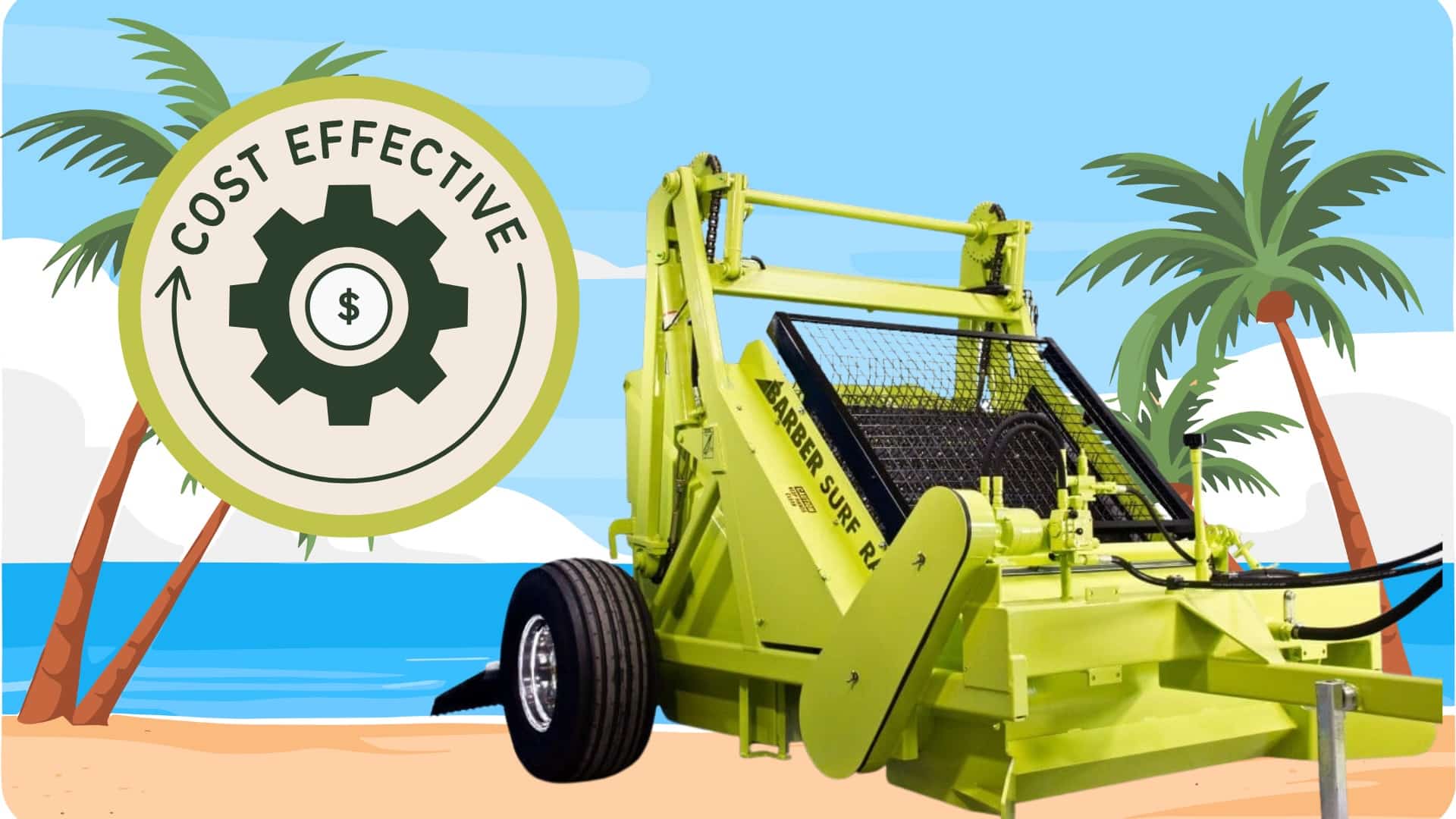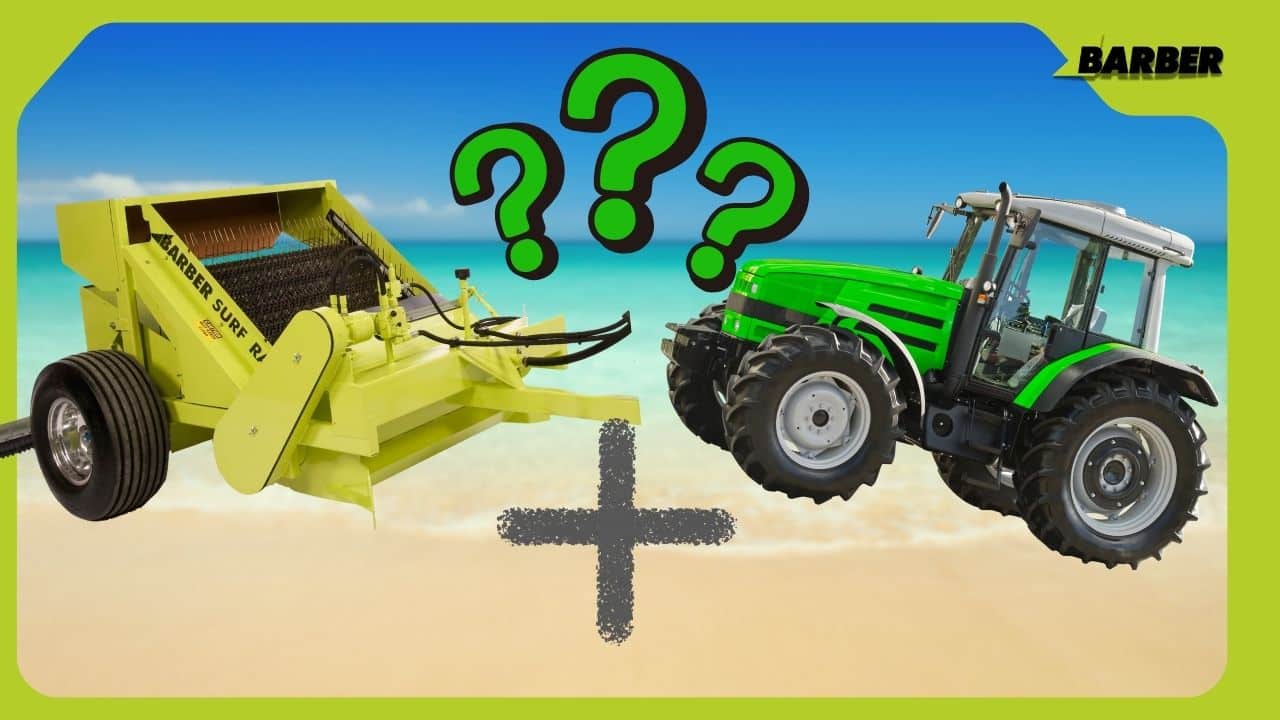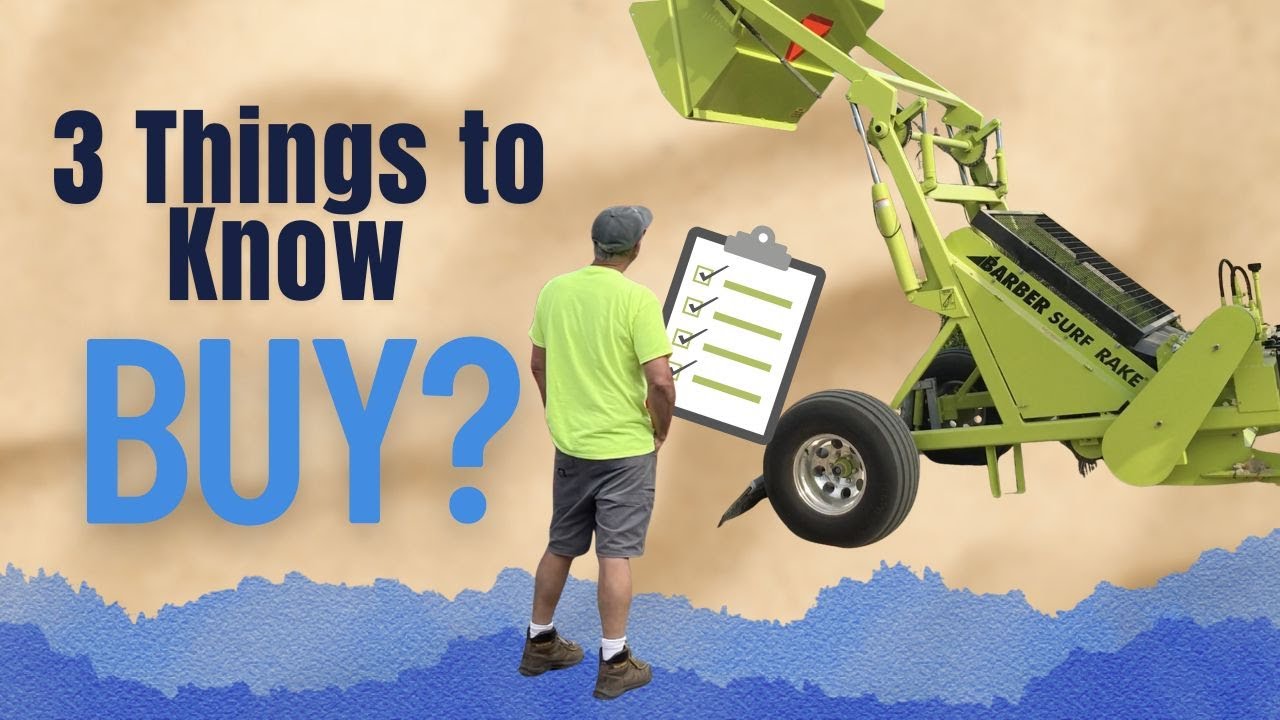When shopping for a beach cleaner, the price differences between models can be confusing. Why is one machine $40,000 while another is $10,000.
This guide breaks down the key beach cleaner features that affect cost so you can understand what you’re paying for, avoid overspending, and choose the right machine for your beach.
[01:00:05:08 – 01:00:10:01]
Designated beach cleaning machines cost between 15,000 to well over a hundred thousand dollars.
[01:00:10:01 – 01:00:16:22]
But what makes one machine cost tens of thousands more than another? And where do your beach cleaning needs fall in that spectrum?
[01:00:17:11 – 01:00:31:04]
When looking at these prices and trying to determine how to prioritize your budget, it can be really helpful to know what features affect this price range so that you can make sure you’re paying for real functionality that translates into tangible results for your beach maintenance program.
[01:00:31:04 – 01:00:35:18]
Instead of overpaying for capacity or features that you don’t need.
[01:00:35:18 – 01:00:50:03]
It’s just like if you’re a single person commuting one mile to work every day in an area where it doesn’t snow, you can probably deprioritize that third row of seating and all wheel drive. But if you had a family of six, you probably want to pay for that larger vehicle.
[01:00:50:03 – 01:00:51:16]
It’s the same way with beach cleaners.
[01:00:53:08 – 01:01:04:20]
So in this video, we’re going to break down the five main factors that influence the cost of a beach cleaning machine so that you can make sure that you’re getting the beach cleaner that will make your beach cleaning program successful without overpaying
[01:01:04:20 – 01:01:05:22]
for what you don’t need.
[01:01:05:22 – 01:01:18:11]
And then at the end of the video, I’m going to throw in a hidden bonus cost that jacks up the list price way more than you’d expect. And it’s one that most prospective beach cleaner buyers forget about and they really shouldn’t.
[01:01:19:12 – 01:01:20:04]
Let’s dive in.
[01:01:22:01 – 01:01:28:18]
As I just mentioned, the list price of a specific beach cleaning machine is typically based on five key factors.
[01:01:29:22 – 01:01:32:00]
First is the machine type.
[01:01:33:03 – 01:01:34:13]
Walk behind beach cleaners and
[01:01:34:13 – 01:01:50:18]
small tractor attachments are the least expensive models and can be great options for small private beaches or beach maintenance teams who need to clean small sandy areas frequently or with a great deal of precision, but they don’t have the resources or the need for more robust cleaning capacity.
[01:01:50:18 – 01:02:02:21]
Designated tractor toad beach cleaning units are the most popular option for professional beach maintenance teams who operate medium and large beaches as well as smaller beaches that get heavy amounts of debris washing up on the beach.
[01:02:02:21 – 01:02:17:19]
Tractor toad beach cleaner is ranging cost a lot, beginning around $30,000 for a small tractor toad unit to averaging around 50, $60,000 for a medium sized unit and scaling up past $100,000 for high capacity units.
[01:02:19:03 – 01:02:51:08]
A third kind of beach cleaner is a self-propelled beach cleaner, which costs significantly more per unit of cleaning capacity than comparable tractor toad units, even though it employs a similar cleaning technology while also adding in a bunch of potential failure points into the mix because of all the extra components like an engine, transmission and electrical components. And this is why at Barbour, we don’t manufacture them. We found that a tractor from a proven manufacturer will be a far more reliable propulsion unit than the proprietary ones found on self-propelled beach cleaners.
[01:02:51:08 – 01:03:03:11]
The second beach cleaner criteria that affects their list price is cleaning with. The wider the machine, the more the machine tends to cost. This is because it requires more components, more raw materials to
[01:03:03:11 – 01:03:16:16]
manufacture. However, with that increased cleaning with, it will take fewer passes to clean the same beach. So you can clean large areas faster. As a general rule, the wider the machine, the greater its cleaning efficiency.
[01:03:16:16 – 01:03:21:05]
Hopper capacity is the third factor that affects how much a beach cleaner costs.
[01:03:21:05 – 01:03:29:11]
Since larger hoppers require larger frames, wider cleaning mechanisms, beach cleaning prices tend to rise proportionally to the hopper size.
[01:03:29:11 – 01:03:32:07]
A large capacity hopper can be a real benefit though,
[01:03:32:07 – 01:03:48:04]
because it allows the beach cleaner to pick up more debris per dump cycle or the amount of time it takes before a machine needs to travel to the dump site to empty its hopper. By reducing the number of dump cycles in the given cleaning, the operator can save significant amounts of time.
[01:03:48:04 – 01:03:57:21]
This can prove especially true on larger beaches, as the machine cleans areas farther and farther from the original dump site, and then needs to return over those areas it’s already cleaned.
[01:03:59:04 – 01:04:06:19]
If you know your dump site is a bit of a distance from the beach, investing in a beach cleaner with a larger hopper would be a real benefit, if not a necessity.
[01:04:06:19 – 01:04:22:11]
In addition to reducing dump cycles, large capacity hoppers are often needed for removing specific types of high volume debris, like sargassum or seaweed, which would simply fill up the hopper on smaller machines too quickly to be a practical for regular use.
[01:04:22:11 – 01:04:27:05]
The dump mechanism is the fourth factor that affects how much a beach cleaning machine costs.
[01:04:27:05 – 01:04:32:12]
Typically, beach cleaners can deposit the debris they collect in two ways, ground dump or
[01:04:32:21 – 01:04:33:13]
high dump.
[01:04:34:16 – 01:04:44:22]
Ground dump can be suitable if there’s a secluded dump site to deposit the debris over time. But if you will need to deposit the debris in a dumpster or in a truck, the high dump option becomes essential.
[01:04:44:22 – 01:04:54:20]
Naturally, with more hydraulic components and more moving parts, the high dump function will cost more than the ground dump models, and are typically found on middle and large size beach cleaners.
[01:04:57:11 – 01:05:04:23]
The fifth major factor that impacts how much a beach cleaning machine costs is whether it includes additional options or customizations.
[01:05:04:23 – 01:05:13:18]
For example, at Barber, we offer a finisher assembly for creating a groomed look on the clean sand, a hydraulic mole board for making cleaning depth adjustments on the go,
[01:05:13:18 – 01:05:24:09]
and hot dip galvanizing to prevent corrosion, not to mention other custom options like safety lights or custom colors or bacteria-reducing rake attachments, auto
[01:05:24:09 – 01:05:29:16]
greasers, dust reduction systems, and well, typically whatever beach cleaning maintenance team is fine they need.
[01:05:29:16 – 01:05:39:20]
By handling all the assembly at our factory, we’ve had the flexibility to make some pretty unique requests. And as you can expect, if you add on an option, you’ll be increasing the price of the machine.
[01:05:41:01 – 01:05:47:08]
One more bonus cost driving factor, one that most beach cleaning buyers don’t consider when they’re comparing machines,
[01:05:47:08 – 01:05:53:20]
It’s the additional costs of ongoing maintenance and repairs you’re signing up for when you get a specific type of machine.
[01:05:53:20 – 01:06:19:05]
While it’s tempting to just look at the list price of a machine, certain beach cleaner types invite higher maintenance and repair costs, which can make a good find now turn into a real headache over time. We’ve put together a free checklist about what to look for in a beach cleaning machine design and manufacturer to make sure that you’re buying a reliable machine that will work for you for the long term and with the fewest headaches. You can find the download link in the description.
[01:06:19:05 – 01:06:27:14]
So which cost-effecting factors are most important for your beach cleaning needs? Which ones are deal breakers versus nice to haves?
[01:06:28:11 – 01:06:34:00]
At Barber, we manufacture a full beach cleaner lineup that covers the full spectrum of beach cleaners
[01:06:34:00 – 01:06:39:07]
from affordable walk behind units, right on up to high capacity industrial tractor-towed units.
[01:06:39:07 – 01:06:46:22]
If you’re in the market and interested in getting an idea of what specific machine could be a good fit for you, we put together a surf rake recommendation tool.
[01:06:46:22 – 01:06:59:20]
It’ll ask you about your beach cleaning needs and then provides you a recommendation for the model of surf rake that would be the best fit for your beach needs and budget. It offers a great starting point for your research
[01:06:59:20 – 01:07:05:00]
and you can find the link to this free tool in the description, no email or contact info required.
[01:07:05:00 – 01:07:09:21]
Thanks for watching. I look forward to sharing some more beach cleaning tips with you in the next video.
[01:07:09:21 – 01:07:17:00]
Below, we’ll unpack the five key features that influence beach cleaner cost, so you can interpret quotes confidently and choose the level of machine that truly fits your beach.
Table of Contents
1. Machine Type:
Walk-Behind, Tractor-Towed or Self-Propelled?
The single biggest driver of beach cleaner cost is the type of machine.
- Walk-Behind Sand Cleaners are intended for fine-cleaning small, sandy areas, like areas with beach chairs, cabanas, or beach volleyball courts, as well as small beaches. They excel at removing small debris and litter but struggle with (or simply don’t work) with larger beach debris. They begin around $15,000 USD.

- Tractor-towed beach cleaning machines are powered by standard agricultural or utility tractors. They’re simpler, more reliable, and easier to service locally. Entry-level models begin around $30,000 USD and scale upward with width and capacity.
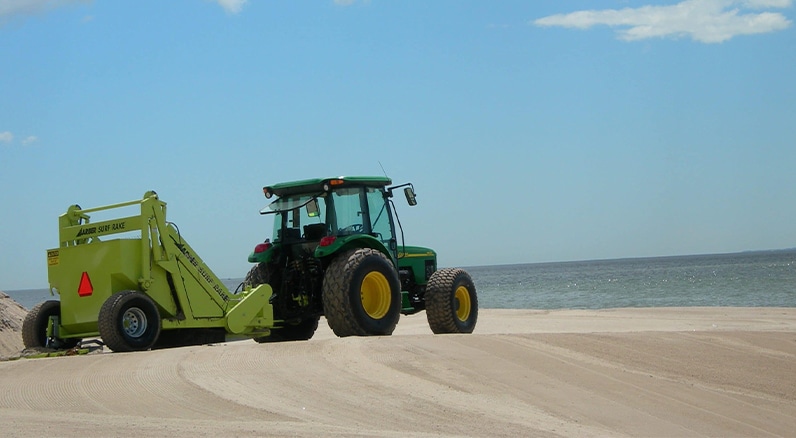
- Self-propelled beach cleaners, by contrast, include their own engine, transmission, and electrical systems. That extra complexity adds tens of thousands of dollars — and more potential failure points. At Barber, we manufacture walk-behind and tractor-towed designs exclusively because they deliver the most dependable cleaning performance with the fewest maintenance headaches.
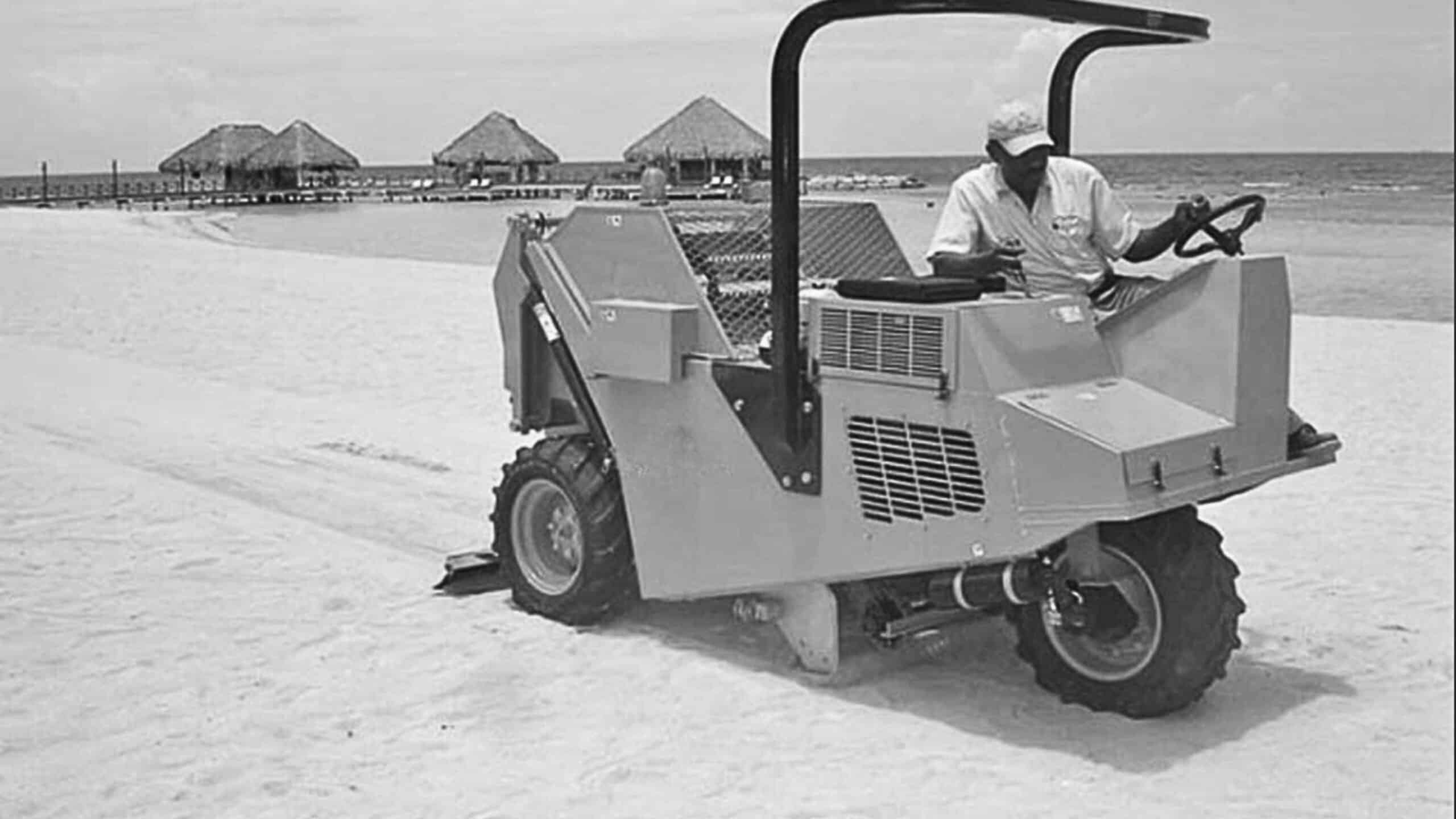
2. Cleaning Width and Overall Size
Larger cleaning widths require more components and raw materials to build, so they naturally cost more. However, this increased size helps them cover more beach in fewer passes, which increases effectiveness and reduces operational costs over time.
For operators maintaining multiple miles of shoreline each morning, the increased upfront cost can quickly pay for itself in operating efficiency.
As a rule of thumb:
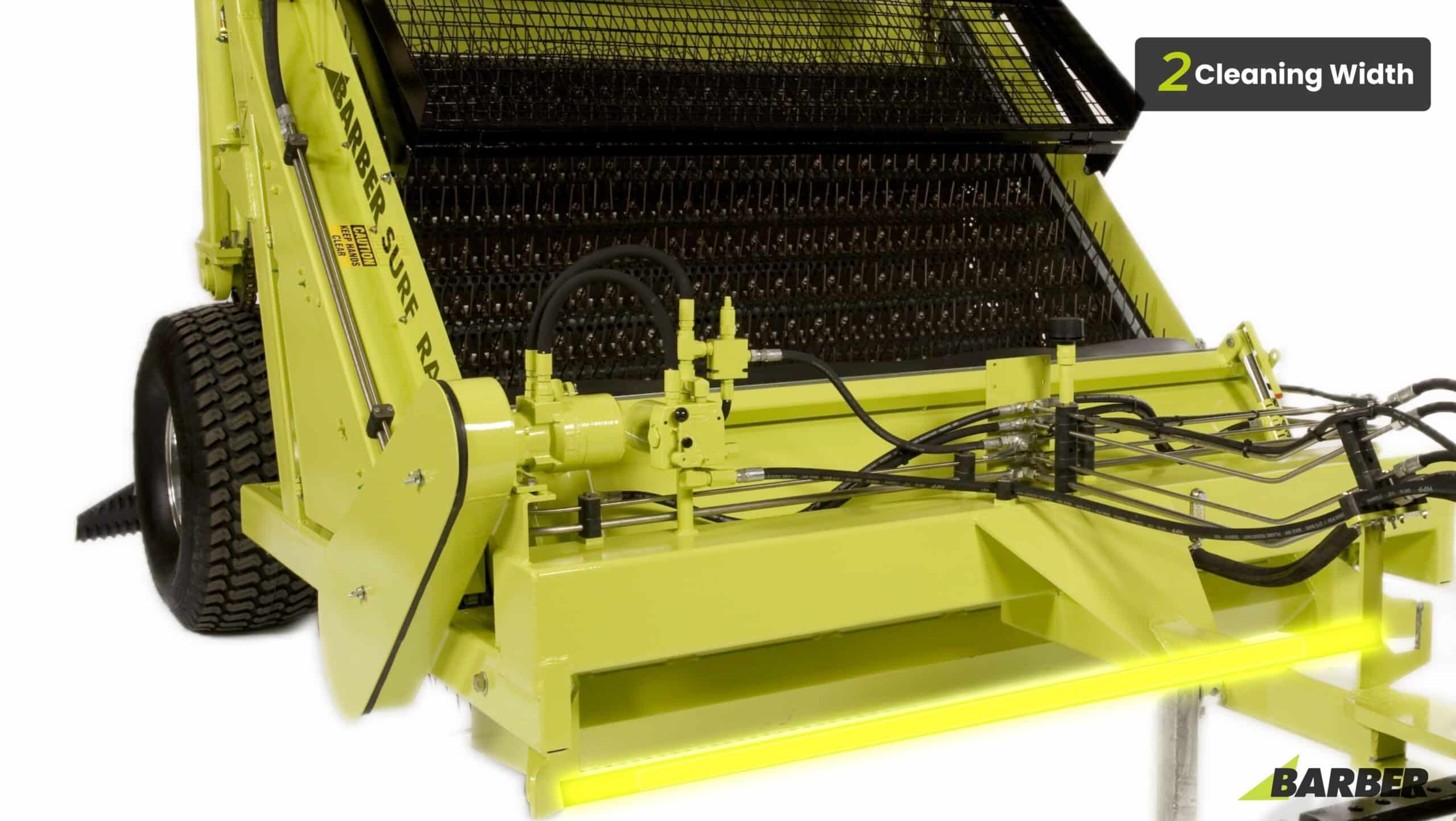
The greater the cleaning width, the greater the efficiency — and the greater the investment.
Cleaning Width
Under 1.5 m
1.8 – 2.1 m
2.4 m +
Typical Use Case
Small or private beaches
Mid-size municipal/resort
Industrial & wide-shoreline ops
Relative Price Tier
Lower
Mid-range
Premium
3. Hopper Capacity
A beach cleaner’s hopper size (the debris-collection bin) directly affects both cost and cleaning productivity.

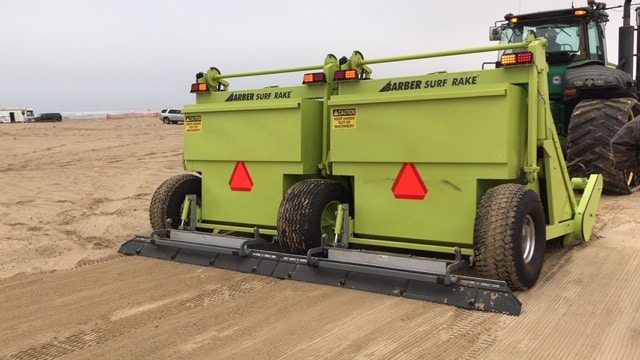
Larger hoppers demand heavier frames and wider rakes, which raise manufacturing cost — yet they allow you to clean longer without stopping to dump.
That matters for large municipal beaches, where dump sites may be hundreds of yards away, or for heavy debris conditions such as sargassum or shell buildup.
If your team spends more time dumping than cleaning, upgrading to a larger hopper can yield measurable daily savings.
4. Dump Mechanism: Ground Dump vs High Dump
How a beach cleaner empties its hopper also influences price and workflow.
- Ground-dump machines simply lower debris onto the sand. They’re affordable and work well when you can stockpile debris in a secluded area for later removal.
- High-dump machines use hydraulic lift systems to deposit debris directly into trucks or trailers — ideal for municipal operations where waste must be hauled away quickly.

High-dump systems add cost and weight but deliver major efficiency advantages when turnaround speed matters.
5. Custom Options and Corrosion-Resistant Features
Finally, price depends on how your beach cleaning machine is configured.
At Barber, every machine is assembled in-house, giving customers the flexibility to tailor it for local conditions:

Sand-Grooming Finisher for creating a uniform 'first step' groomed sand look.
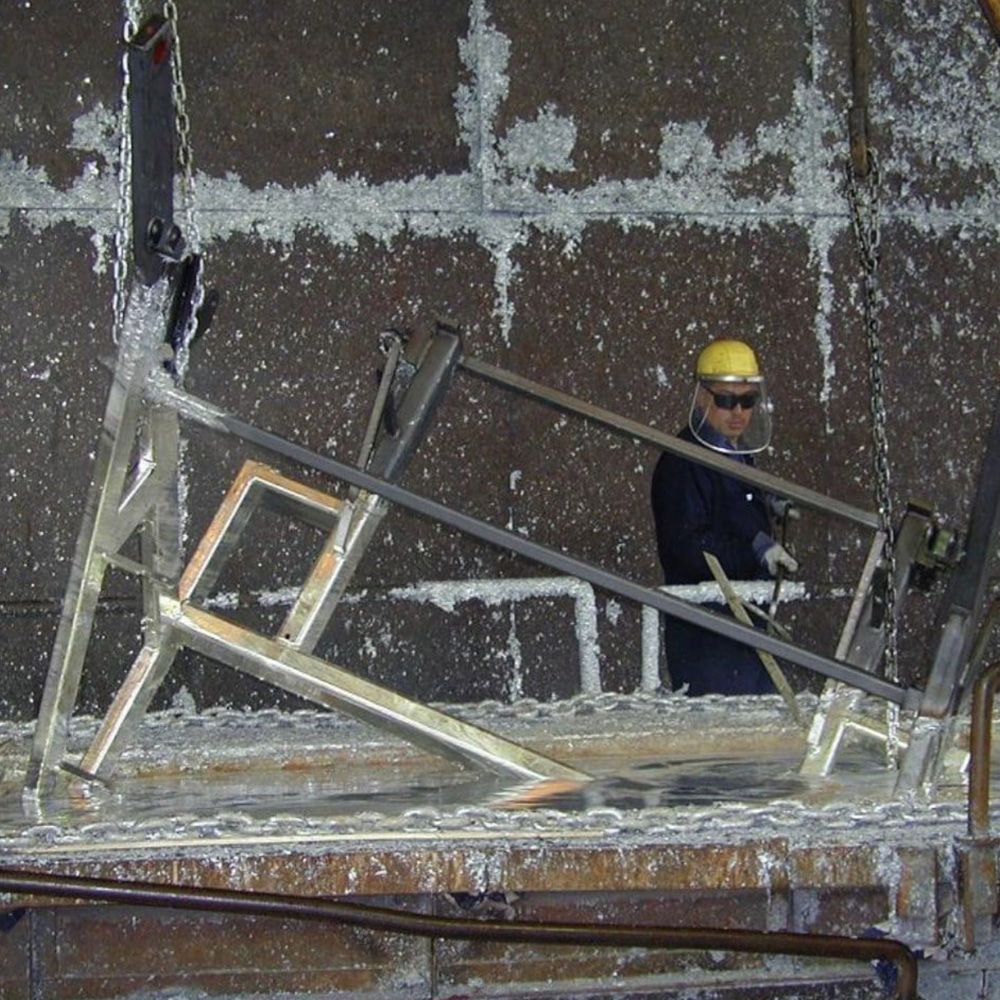
Hot-dip galvanizing or stainless steel for corrosion resistance
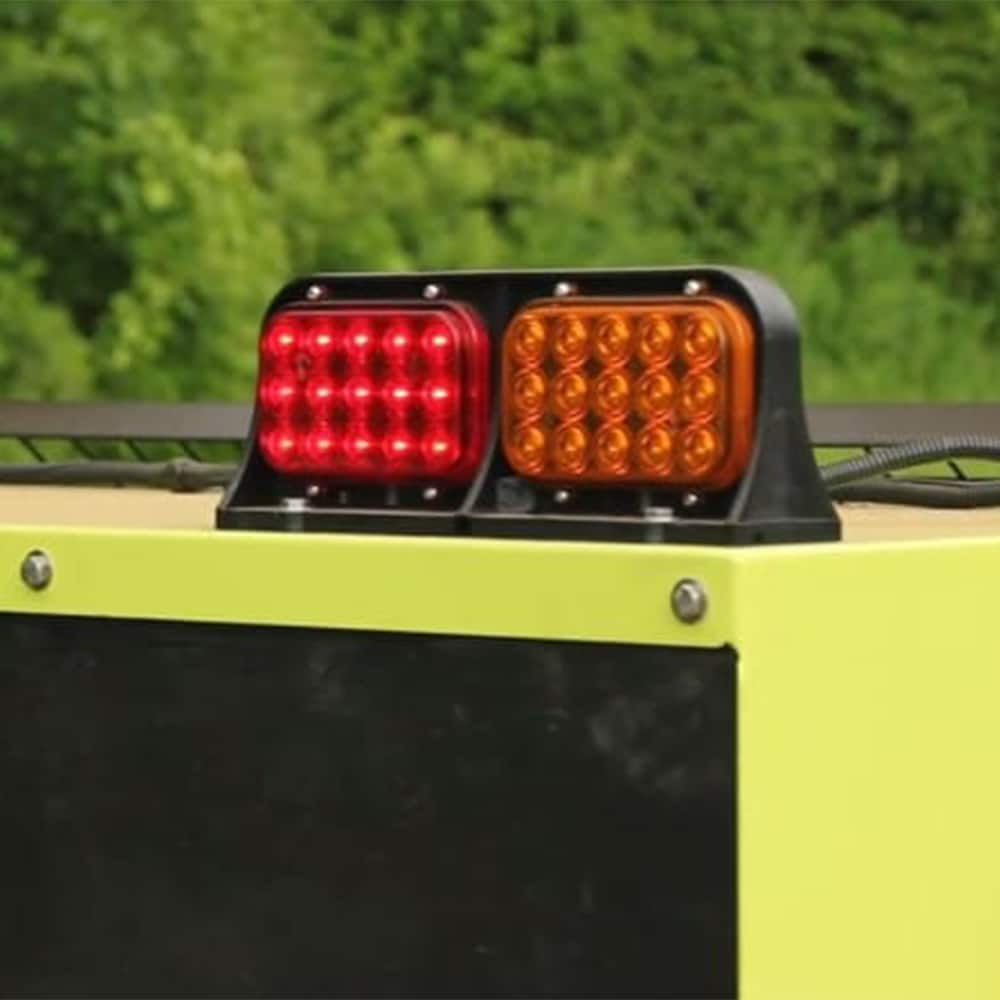
Safety lights, signage, or reflective markings for municipal visibility
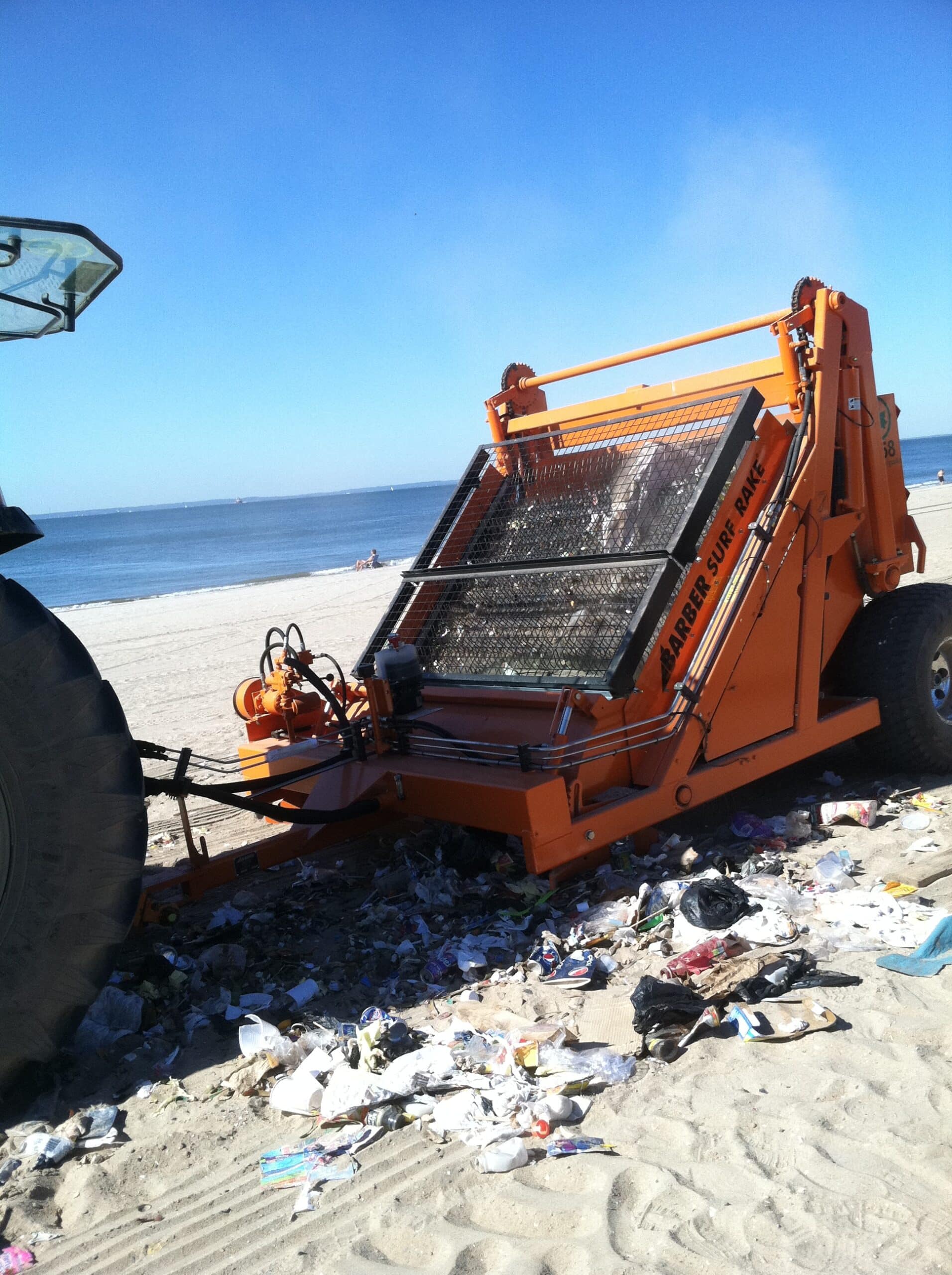
Custom colors or branding for cohesive fleet presentation

Bacteria-reducing rake attachments for health-conscious resorts

On-board grease systems or tool mounts for maintenance ease
Each addition increases cost slightly, but smart customization can dramatically extend the functionality and/or service life of your equipment — especially in high-salt or high-use environments.
Bonus Factor: Long-Term Maintenance and Ownership Cost
It’s tempting to compare beach cleaner prices only by the initial quote, but long-term maintenance costs often tell the real story.
Machines with more moving parts, electronics, and proprietary engines tend to require more frequent repairs and downtime. A simpler, mechanical design with corrosion-resistant materials can save a lot of money and headaches over time.
Meanwhile, a “budget” machine that’s down for repairs during peak season can cost more in lost service days than it saved on day one.
You can read more on our blog post about the design factors that influence long-term machine maintenance and repair costs.
Choosing the Right Level for Your Beach
When reviewing quotes, focus less on the dollar figure and more on how each feature supports your specific operation.
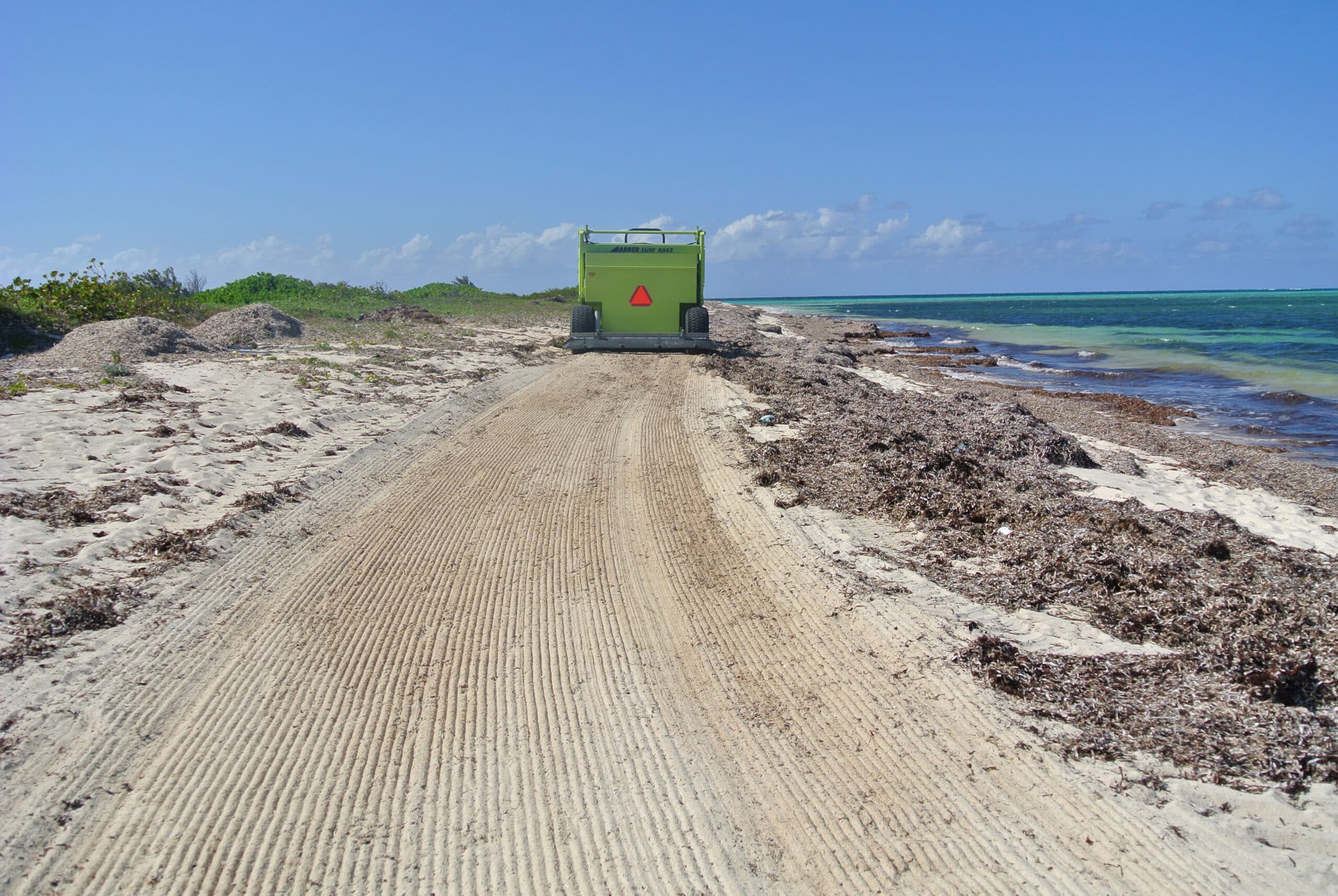
Municipal buyers may prioritize wide cleaning widths, high-dump systems, and corrosion protection for year-round reliability.
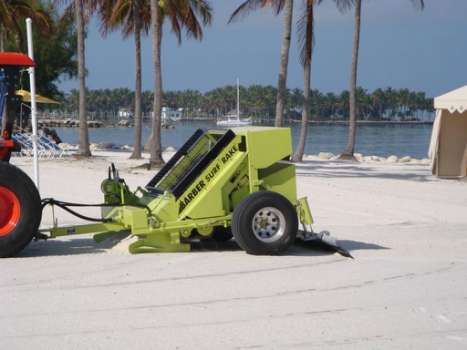
Resort operators often prefer smaller, more maneuverable models that deliver excellent surface finish and quiet operation.

Private property owners might value simplicity and easy storage over capacity.
If you’re unsure which configuration fits your beach and budget, try our Surf Rake Recommendation Tool. It will provide you with a baseline recommendation for a Surf Rake based on your answers to five multiple choice questions that cover beach cleaning needs and budgets.
Conclusion: Pay for What You Need — and Nothing You Don’t
Beach cleaner prices are relatively consistent across the industry, but the variables that affect cost — machine type, size, hopper capacity, dump mechanism, and customization — make it difficult to post one definitive number.
By understanding these factors, you’ll be able to evaluate quotes with confidence, ensure you’re paying for real functionality, and invest in a beach cleaning machine that delivers years of reliable service.
Ready to Find Your Fit?
👉 Try the Surf Rake Recommendation Tool — it’s quick, free, and requires no contact info.
Get a personalized starting point for your beach cleaning needs before requesting a quote.
👉 Ready to get personalized recommendations from our expert team? Contact Us for more information and quotes.
Frequently Asked Questions
Because pricing depends on variables like configuration, tariffs, shipping distance, and current steel costs. Most reputable manufacturers quote individually so buyers only pay for the features they actually need.
With proper maintenance and storage, a quality tractor-towed beach cleaner can operate reliably for 15–25 years. Models with hot-dip galvanizing or stainless components often last even longer.
Yes. Many neighboring towns or resort groups co-own a single unit and schedule weekly rotations. Barber machines are designed for fast tractor hookup, making shared use practical.
Most mid-range utility tractors in the 30–100 HP range with standard PTO and drawbar connections can tow a Surf Rake. Barber provides specific tractor recommendations with each model quote. Learn more about tractor requirements for beach cleaning here.
In most cases, no. They introduce proprietary powertrains that require specialized factory repair, as opposed to tractor-towed models, which leverage proven equipment you likely can get serviced locally.
Well-maintained Barber machines hold strong resale value because of their mechanical simplicity and durability. Many customers recoup a substantial portion of their investment even after a decade of service.


